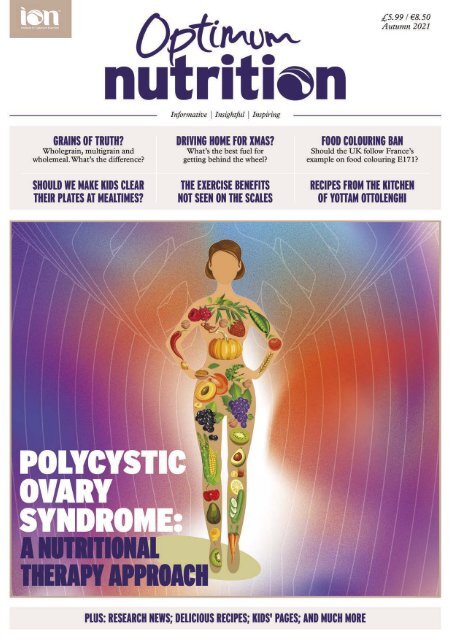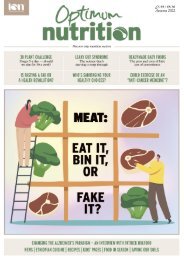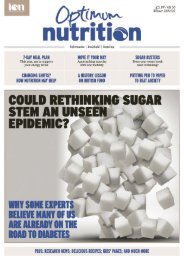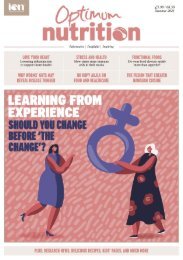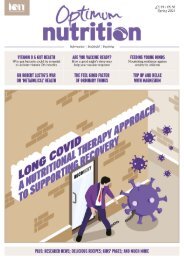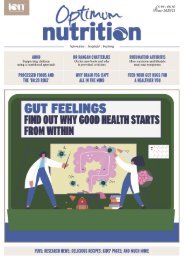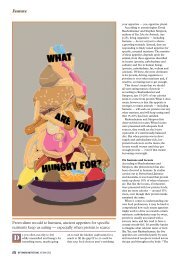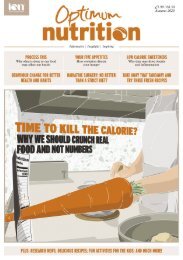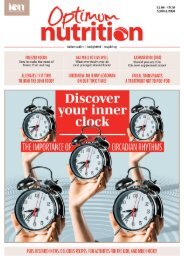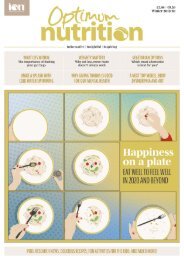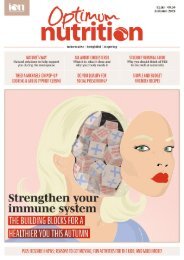Optimum Nutrition - Autumn 2021 - PREVIEW
A nutritional therapy approach to polycystic ovary syndrome (PCOS) | Community chef Sanjay Kumar on slow food, and how he’s working to eradicate food poverty | Recipes from the Ottolenghi Test Kitchen | A fresh look at the hygiene hypothesis | Food additives: is there a price for pretty products? | Your ultimate winter survival kit | Plus kids pages, research updates and more!
A nutritional therapy approach to polycystic ovary syndrome (PCOS) | Community chef Sanjay Kumar on slow food, and how he’s working to eradicate food poverty | Recipes from the Ottolenghi Test Kitchen | A fresh look at the hygiene hypothesis | Food additives: is there a price for pretty products? | Your ultimate winter survival kit | Plus kids pages, research updates and more!
- No tags were found...
Create successful ePaper yourself
Turn your PDF publications into a flip-book with our unique Google optimized e-Paper software.
IN THIS ISSUE<br />
8<br />
A NUTRITIONAL THERAPY APPROACH TO POLYCYSTIC OVARY SYNDROME (PCOS)<br />
Alice Ball finds out how nutrition and lifestyle can help to support symptoms<br />
12<br />
DIFFERENT STROKES<br />
Breeze through winter by looking after<br />
the physical, intellectual, emotional and<br />
social you<br />
20 RESEARCH UPDATE 24<br />
A fresh look at the ‘hygiene hypothesis’<br />
and recent findings on omega-3s,<br />
headaches and heart health<br />
KITCHEN CHEMISTRY<br />
14 ALL ABOUT<br />
16<br />
Food colouring E171 may not be safe<br />
for human consumption. Here’s why<br />
and how to identify it on the label<br />
FUELLING UP<br />
Driving home for Christmas? Find out<br />
how fuelling up with good nutrition<br />
may help you behind the wheel<br />
30 INTERVIEW<br />
STORECUPBOARD HERO 36<br />
Community chef Sanjay Kumar talks to<br />
us about slow food, and working with<br />
people living in food poverty<br />
38<br />
Judith Orrick looks at how cooking<br />
methods can help to maximise the<br />
health benefits of a Mediterranean diet<br />
44<br />
FOOD FACT FILE<br />
Wholegrain, multigrain and wholemeal;<br />
what’s the difference and are they for<br />
everyone? Louise Wates writes<br />
33<br />
Why the humble can of salmon deserves<br />
a mention for affordable and versatile<br />
nutrition<br />
39<br />
IN SEASON<br />
Find out how fennel bulb can add a<br />
touch of Italy to your table, and about<br />
the many uses of fennel seeds<br />
48 MOVE IT<br />
50<br />
Giulia Basana and Alice Ball look at<br />
whether it’s wise to get a little bit fitter<br />
— before trying to get fit<br />
ON YOUR PLATE<br />
Three teaser recipes from Shelf Love,<br />
the new book freshly served from the<br />
Ottolenghi Test Kitchen<br />
LITTLE LIVES<br />
Catherine Morgan finds out how<br />
insisting children clear their plate could<br />
lead to disordered eating later in life<br />
A MIRACLE PILL?<br />
The old adage goes that exercise<br />
promotes weight loss. Alice Ball looks<br />
at why this is fundamentally wrong<br />
WORLD CUISINE<br />
Food writer Uyen Luu tells us about the<br />
flavours of Vietnam and shares a recipe<br />
from her latest cookbook<br />
GRADUATE STORY<br />
Find out how Joy Skipper went from<br />
photographing horses to nutritional<br />
therapy — via MasterChef on the way<br />
04 COMMENT & NEWS | 26 KIDS’ PAGES | 34 FROM ION | 40 BOOK THERAPY | 47 PRODUCT NEWS<br />
28<br />
42<br />
OPTIMUM NUTRITION | AUTUMN <strong>2021</strong><br />
3
Feature<br />
POLYCYSTIC OVARY<br />
SYNDROME:<br />
Image: orawanpat © 123RF.com<br />
A NUTRITIONAL<br />
THERAPY<br />
APPROACH<br />
Alice Ball looks at the complexities of polycystic ovary syndrome, which is thought to affect<br />
one in 10 women, and how nutrition and lifestyle may help to manage symptoms<br />
M<br />
y acne started when I was<br />
“ a teenager and I was told I<br />
had high testosterone. I was<br />
immediately put on a birth control<br />
pill which I remained on for about 10<br />
years.” Registered nutritional therapist<br />
Lauren Lovell didn’t know she had<br />
polycystic ovary syndrome (PCOS)<br />
until her late twenties. It was only when<br />
her sister was diagnosed as an adult that<br />
she decided to get investigated, due to<br />
the chronic and persistent acne she was<br />
experiencing.<br />
“It took some convincing to get<br />
a referral for an ultrasound but I<br />
eventually did, and multiple cysts were<br />
found on my ovaries,” she says. “This,<br />
coupled with the high testosterone, led<br />
to the diagnosis.”<br />
PCOS is thought to be one of the<br />
most common hormonal conditions,<br />
affecting around one in 10 women.<br />
Yet it is also often overlooked and<br />
under-managed. A survey of 1,385<br />
women from 48 different countries<br />
who had been diagnosed with PCOS<br />
revealed that it had taken one third<br />
(33.6%) more than two years to receive<br />
a diagnosis; nearly half (47.1%) had<br />
seen three or more health professionals<br />
before receiving a diagnosis; and only<br />
15.6% said they were satisfied with the<br />
information they received. 1<br />
It’s an experience to which Lovell can<br />
relate. “I wasn’t offered any treatment<br />
IN BRIEF<br />
• Whilst there is no ‘cure’ for PCOS,<br />
a healthy lifestyle can help to<br />
reduce symptoms and long term<br />
health risks.<br />
• Between 50-70% of women with<br />
PCOS have insulin resistance.<br />
• An anti-inflammatory,<br />
Mediterranean-style diet<br />
with plenty of colourful fruits<br />
and vegetables for fibre,<br />
micronutrients and antioxidants,<br />
plus good quality protein and<br />
healthy fats can support PCOS.<br />
• Omega-3 fatty acids, vitamin D,<br />
zinc and vitamin A can support<br />
inflammation, skin and gut health<br />
to better manage PCOS.<br />
• Managing stress and maintaining a<br />
healthy weight are also key.<br />
as I didn’t have insulin resistance nor<br />
was I trying to conceive,” she says.<br />
Lovell isn’t alone. Mimi Hawary, 28,<br />
told <strong>Optimum</strong> <strong>Nutrition</strong> that it took five<br />
years to receive a PCOS diagnosis. “I<br />
didn’t get my first period until I was<br />
around 15,” she says. “When it started,<br />
it was so erratic and horrendously<br />
painful. I could go six months without a<br />
period but the doctors always said I was<br />
young and it would settle.”<br />
She was eventually sent for blood<br />
tests six months after her 20th birthday.<br />
“But they came back ‘inconclusive’ so<br />
the GP asked me to do a blood test<br />
on the first day of my cycle,” she says.<br />
“This was really frustrating because<br />
my periods were so irregular I couldn’t<br />
predict when the first day would be.”<br />
Hawary also had an ultrasound done<br />
privately. “The technician literally said,<br />
‘I’ve lost count of how many cysts are<br />
on your ovaries’,” she says. “When I<br />
asked about my chances of conceiving,<br />
he said that judging by the amount of<br />
cysts I had it was ‘slim to no chance of<br />
conceiving without medical assistance’.<br />
But he couldn’t say for definite because<br />
that’s just one symptom.”<br />
She was referred to a hormone<br />
specialist, then to a gynaecologist who<br />
offered her the contraceptive pill or coil.<br />
But in 2018, she started to lose a lot of<br />
weight. “By November my periods had<br />
become regular,” she says. “By April<br />
2020, I had lost about 35kg in total and<br />
also fell pregnant for the first time. My<br />
“The length of time to diagnosis can mean that women suffer for<br />
far longer than they should with their symptoms…We would always<br />
encourage women to speak to their doctor”<br />
8 OPTIMUM NUTRITION | AUTUMN <strong>2021</strong>
Feature<br />
daughter is now seven months old.”<br />
Dr Caroline Overton, a spokesperson<br />
for the Royal College of Obstetricians<br />
and Gynaecologists, explains that<br />
because symptoms of PCOS can<br />
come and go, and because there is a<br />
varying scale of symptoms, it can make<br />
it difficult for women like Lovell and<br />
Hawary to receive a diagnosis.<br />
“The length of time to diagnosis can<br />
mean that women suffer for far longer<br />
than they should with their symptoms,”<br />
she says. “We would always encourage<br />
women to speak to their doctor if they<br />
are having symptoms and ask to have<br />
a second opinion or be referred to a<br />
gynaecologist if they feel that they are<br />
not getting answers.”<br />
She adds that whilst there is no cure<br />
for PCOS, there are ways in which<br />
women can manage their symptoms.<br />
“Medical treatments aim to manage<br />
and reduce symptoms which, when<br />
coupled with a healthy lifestyle, can<br />
reduce any long term health risks,” she<br />
says.<br />
“Leading a healthy lifestyle is one of<br />
the main ways to reduce the risks of any<br />
long term health issues associated with<br />
PCOS. This includes eating a balanced<br />
and healthy diet, eating regular meals,<br />
and regular exercise.<br />
“Maintaining a healthy BMI [body<br />
mass index] can help to manage<br />
symptoms of PCOS, and can reduce<br />
the risk of heart problems, high blood<br />
pressure and cancer. Having a healthy<br />
weight can also increase the likelihood<br />
of having regular periods and increase<br />
fertility.”<br />
Insulin resistance<br />
According to research, between 50 to<br />
70% of women with PCOS have insulin<br />
resistance, 3 which is when cells stop<br />
responding to the hormone insulin.<br />
Insulin is a hormone that regulates<br />
blood sugar. When we eat, food is<br />
broken down into sugar (glucose),<br />
which enters the bloodstream and<br />
WHAT IS PCOS?<br />
PCOS is a condition that can affect periods, fertility and aspects of appearance.<br />
According to NHS guidelines, at least two of the following three criteria should<br />
be present in order for a diagnosis to be made: 2<br />
• Excess androgens; a name given to a group of hormones that includes<br />
testosterone, DHEA-S and androstenedione. High levels of these hormones<br />
can result in excessive facial or body hair, oily skin, acne, thinning or hair loss,<br />
weight gain and mood changes.<br />
• Polycystic ovaries; these are egg follicles that haven’t been released upon<br />
ovulation and end up ‘stuck’ on the ovaries.<br />
• Irregular or absent periods; caused by a lack of ovulation.<br />
When it comes to specific nutrients…omega-3 fatty acids, vitamin D,<br />
zinc, vitamin A and adequate protein can support inflammation, skin<br />
and gut health to better manage PCOS symptoms...<br />
signals the pancreas to release insulin.<br />
The insulin then lowers the blood<br />
glucose levels by stimulating uptake into<br />
cells, where it can be stored as glycogen<br />
until it’s needed for energy.<br />
With a lot of glucose in the<br />
bloodstream, however, the pancreas has<br />
to produce more insulin to get it into<br />
the cells. Over time, cells can eventually<br />
stop responding to the insulin,<br />
becoming insulin resistant, which is a<br />
precursor to type 2 diabetes.<br />
When it comes to PCOS, Lovell<br />
explains that excess insulin can impair<br />
ovulation, causing the ovaries to<br />
produce more androgens and resulting<br />
in associated symptoms such as acne<br />
and hair thinning. “High insulin also<br />
reduces sex hormone binding globulin<br />
(SHBG),” she says. SHBG is like a<br />
sponge for excess hormones, so if there<br />
are lower amounts in the body then<br />
there will be more androgen hormones<br />
running free.<br />
According to Lovell, balancing blood<br />
sugar and insulin levels are therefore key<br />
in the management of PCOS. “Avoiding<br />
refined carbohydrates and too much<br />
sugar is helpful,” she says. “An antiinflammatory,<br />
Mediterranean-style<br />
diet with plenty of colourful fruits and<br />
vegetables for fibre, micronutrients and<br />
antioxidants, plus good quality protein<br />
and healthy fats can support PCOS.”<br />
When it comes to specific nutrients,<br />
she says that omega-3 fatty acids,<br />
vitamin D, zinc, vitamin A and adequate<br />
protein can support inflammation, skin<br />
and gut health to better manage PCOS<br />
symptoms. “I might also consider<br />
nutrients like magnesium, alpha-lipoic<br />
acid [found in yeast, liver, kidney,<br />
spinach and broccoli] and myo-inositol<br />
[vitamin B8] which can help to regulate<br />
insulin sensitivity,” she adds.<br />
The breakfast club<br />
Women with PCOS and insulin<br />
resistance might also benefit from<br />
enjoying a bigger breakfast, according<br />
to a study from Tel Aviv University,<br />
Israel. 4<br />
Sixty women suffering from PCOS<br />
with a normal BMI were randomly<br />
assigned to one of two calorie<br />
maintenance diets with identical foods<br />
for 12 weeks. One group consumed<br />
more of their calories at breakfast and<br />
reduced their calorie intake through the<br />
rest of the day, whilst the other group<br />
had a smaller breakfast and consumed<br />
the majority of their calories in their<br />
evening meal.<br />
Neither group experienced a change<br />
in BMI, but whilst participants in<br />
the ‘big dinner’ group maintained<br />
consistently high levels of insulin and<br />
testosterone throughout the study,<br />
those in the ‘big breakfast’ group<br />
experienced a 56% decrease in insulin<br />
resistance and a 50% decrease in<br />
testosterone. These reductions led to a<br />
50% rise in ovulation rate by the end of<br />
the study.<br />
Professor Oren Froy, the study’s<br />
lead author, said: “The research<br />
clearly demonstrates that indeed the<br />
amount of calories we consume daily<br />
is very important, but the timing as to<br />
when we consume them is even more<br />
important.”<br />
Gut health<br />
Increasingly, research also highlights<br />
the importance of gut health. According<br />
to Lovell, imbalances in bacteria within<br />
the gut microbiome can contribute to<br />
inflammation and associated metabolic<br />
disorders. The growth of so-called ‘bad’<br />
bacteria can also “impede the proper<br />
excretion of hormones from the body”,<br />
she says, “which can drive PCOS and<br />
make symptoms worse”.<br />
Investigating the impact of gut<br />
bacteria on PCOS, researchers from the<br />
University of California’s San Diego<br />
School of Medicine, USA, found that<br />
women with PCOS had less diverse<br />
populations of gut bacteria compared<br />
to those without the condition and<br />
compared to those with polycystic<br />
ovaries but no other features of PCOS. 5<br />
This lack of diversity in gut bacteria,<br />
the researchers said, was also linked to<br />
elevated testosterone levels, suggesting<br />
that testosterone and other androgen<br />
OPTIMUM NUTRITION | AUTUMN <strong>2021</strong><br />
9
On Your Plate<br />
GRILLED COURGETTES WITH WARM<br />
YOGHURT AND SAFFRON BUTTER<br />
Noor and Yotam say:<br />
“This recipe is inspired by kousa b’laban, a Levantine dish of stuffed baby marrow cooked in yoghurt. In this simplified version,<br />
the yoghurt sauce and grilled courgettes are cooked separately, then served with a quick saffron butter to spoon on top. There’s<br />
a bit of an art to cooking yoghurt without having it curdle; stabilisers such as cornflour and egg yolk tend to do the trick, as does<br />
cooking the yoghurt on a moderate heat, stirring continuously and gently warming through without boiling. The result: a silkysmooth<br />
and tangy sauce, great for these courgettes but also with other grilled veggies, fatty meats or even as a sauce to pasta.”<br />
Prep 10 mins | Cook 30 mins<br />
Ingredients<br />
• 30g unsalted butter<br />
• ¼ tsp saffron threads, roughly<br />
crushed<br />
• 4 small, pale green or regular<br />
courgettes, tops trimmed slightly and<br />
courgettes halved lengthways (600g)<br />
• 2½ tbsp olive oil<br />
• 1 tsp cornflour<br />
• 300g Greek-style yoghurt<br />
• 2 garlic cloves, crushed<br />
• ½ tsp dried mint<br />
• ¾ tsp coriander seeds, toasted and<br />
roughly crushed with a pestle and<br />
mortar<br />
• 1½ tbsp mint leaves<br />
• ½ lemon<br />
• Salt and black pepper<br />
Method<br />
Preheat the oven to a high grill setting.<br />
Put the butter and saffron into a<br />
small saucepan on a medium heat.<br />
When the butter has melted, set aside<br />
to infuse.<br />
Place the courgettes on a parchmentlined<br />
baking tray and toss with 2 tbsp<br />
of oil, ⅓ tsp of salt and a good grind<br />
of pepper. Arrange them cut side up<br />
and grill for 15–20 mins, until nicely<br />
charred and softened.<br />
Towards the last 10 mins of grilling<br />
time, make the sauce. In a large bowl,<br />
whisk together the cornflour and<br />
3 tbsp of water until smooth, then<br />
add the yoghurt, garlic, dried mint,<br />
the remaining ½ tbsp of oil and ½<br />
tsp of salt. Whisk to combine, then<br />
transfer to a large, non-stick sauté<br />
pan on a medium heat. Cook, stirring<br />
continuously, for about 10 mins, or<br />
until thickened slightly and warmed<br />
through. Do not let the sauce boil, or it<br />
will split.<br />
Transfer the warm yoghurt sauce<br />
to a plate with a lip and top with the<br />
courgettes, grilled side up. Spoon over<br />
the saffron butter, then sprinkle with<br />
the coriander seeds and mint leaves.<br />
Squeeze over the lemon half and serve<br />
right away.<br />
Make it your own<br />
• No saffron? Use a pinch of turmeric<br />
instead.<br />
18 OPTIMUM NUTRITION | AUTUMN <strong>2021</strong>
DO YOU<br />
HAVE<br />
AN APPETITE<br />
FOR<br />
NUTRITION?<br />
Take our quiz to test your nutrition knowledge<br />
a<br />
b<br />
c<br />
a<br />
b<br />
c<br />
a<br />
b<br />
c<br />
a<br />
b<br />
c<br />
a<br />
b<br />
c<br />
1. WHICH IS HIGHER IN VITAMIN C?<br />
A red pepper, raw<br />
An orange<br />
A kiwifruit<br />
2. WHAT GIVES CARROTS AND SWEET<br />
POTATOES THEIR ORANGE COLOUR?<br />
Lycopene<br />
Beta-carotene<br />
Tartrazine<br />
3. WHICH FOOD DOES NOT COUNT<br />
TOWARDS YOUR FIVE-A-DAY<br />
Sweet potato<br />
Potato<br />
Baked beans<br />
4. WHAT DOES THE BODY PRODUCE<br />
USING BETA-CAROTENE?<br />
Vitamin A<br />
Vitamin B<br />
Cholesterol<br />
5. WHAT IS A PREBIOTIC?<br />
Food for your gut bacteria<br />
Something your doctor prescribes<br />
A supplement containing beneficial<br />
microbes<br />
a<br />
b<br />
c<br />
a<br />
b<br />
c<br />
a<br />
b<br />
c<br />
a<br />
b<br />
c<br />
a<br />
b<br />
c<br />
a<br />
b<br />
c<br />
6. WHICH SPICE IS ASSOCIATED<br />
WITH BENEFITS FOR BLOOD SUGAR<br />
REGULATION<br />
Turmeric<br />
Cinnamon<br />
Nutmeg<br />
7. WHICH VITAMIN AIDS IRON<br />
ABSORPTION?<br />
Vitamin C<br />
Vitamin D<br />
Vitamin A<br />
8. WHICH IS CONSIDERED AN OILY<br />
FISH AND A GOOD SOURCE OF<br />
OMEGA-3 FATS?<br />
Cod<br />
Haddock<br />
Mackerel<br />
9. FERMENTED FOODS SUCH AS<br />
SAUERKRAUT, KIMCHI AND KEFIR<br />
ARE COMMONLY EATEN FOR THEIR:<br />
Gut health benefits<br />
Heart health benefits<br />
Eye health benefits<br />
10. WHICH OF THE FOLLOWING IS NOT<br />
A TYPE OF SUGAR?<br />
Maltodextrin<br />
Barley malt syrup<br />
Locust bean gum<br />
11. WHICH SPICE IN CURRY<br />
IS CONSIDERED TO BE ANTI-<br />
INFLAMMATORY?<br />
Turmeric<br />
Coriander<br />
Cumin<br />
a<br />
b<br />
c<br />
a<br />
b<br />
c<br />
a<br />
b<br />
c<br />
a<br />
b<br />
c<br />
12. APPROXIMATELY HOW MANY<br />
GRAMS OF SUGAR ARE IN ONE<br />
TEASPOON?<br />
7<br />
4<br />
2<br />
13. WHICH VEGETABLE IS A GOOD<br />
SOURCE OF CALCIUM?<br />
Kale<br />
Radishes<br />
Carrots<br />
14. WHAT IS THE RECOMMENDED<br />
INTAKE OF FIBRE FOR ADULTS?<br />
80g<br />
10g<br />
30g<br />
15. WHICH HAS THE HIGHEST SUGAR<br />
CONTENT?<br />
Mango<br />
Pear<br />
Grapefruit<br />
HOW DID YOU SCORE?<br />
1-5: GOOD EFFORT!<br />
You might be interested in our free,<br />
bite-size video series Food as Fuel,<br />
designed to cut through the myths and<br />
false information about nutrition.<br />
Sign up at ion.ac.uk/food<br />
6-9: IMPRESSIVE!<br />
Have you considered subscribing to<br />
<strong>Optimum</strong> <strong>Nutrition</strong>? You’ll be able to keep<br />
up to date with the latest in health and<br />
nutrition with a new issue delivered to<br />
you every quarter.<br />
Subscribe at ion.ac.uk/mag<br />
9+: YOU CLEARLY KNOW YOUR<br />
STUFF!<br />
Why not take things a step further<br />
and study nutritional therapy with the<br />
Institute for <strong>Optimum</strong> <strong>Nutrition</strong>?<br />
Find out more at ion.ac.uk/nt<br />
ANSWERS: 1. a / 2. b / 3. b / 4. a / 5. a / 6. b / 7. a /<br />
8. c / 9. a / 10. c / 11. a / 12. b / 13. a / 14. c / 15. a<br />
OPTIMUM NUTRITION | AUTUMN <strong>2021</strong><br />
19
Interview<br />
IT ALL<br />
STARTS<br />
WITH<br />
ONE...<br />
Community chef Sanjay Prosenjit Kumar tells Alice Ball how his culinary travels fuelled his<br />
passion for slow food, and how he’s working to eradicate food poverty one person at a time<br />
30 OPTIMUM NUTRITION | AUTUMN <strong>2021</strong>
Interview<br />
S<br />
ardines weren’t born in<br />
“ Cornwall, they came to<br />
Cornwall. I wasn’t born in<br />
Cornwall, I went there. Cooking<br />
brought me here and gave me a<br />
passport. It is my role to give something<br />
back to cooking by teaching people to<br />
eat better.”<br />
Sanjay Prosenjit Kumar would<br />
compare himself to a sardine. Just like<br />
the small fish, which migrate from<br />
the Mediterranean up to the coast of<br />
Cornwall, the Indian-born chef has<br />
travelled far and wide throughout his<br />
career; from the royal kitchens of Saudi<br />
Arabia to training under Raymond Blanc<br />
in Oxford.<br />
Now based in Hertfordshire, Kumar<br />
has spent the past decade working as a<br />
food activist, using a skills based approach<br />
to tackle food poverty. In 2012, whilst<br />
living in Truro, he founded the aptly<br />
named School of Cornish Sardines, a<br />
mobile cookery school that teaches people<br />
to eat well on a shoestring.<br />
The enterprise came about after<br />
Kumar was asked to perform a cookery<br />
demonstration for a local school as part of<br />
Falmouth Oyster Festival.<br />
“I went into the kitchen and there<br />
was a big deep fat fryer waiting to fry<br />
sausages,” he says. “That was when my<br />
jaw dropped. [We’re doing] all of these<br />
demonstrations for people who can afford<br />
oysters. What are we doing for these<br />
children who are the consumers of the<br />
future?”<br />
Inspired to tackle the problem directly,<br />
he enrolled onto a social enterprise<br />
course.<br />
“In Cornwall there is this dichotomy<br />
where there’s lots of fresh produce,<br />
but there is so much food poverty,” he<br />
explains. “My idea was using cooking as<br />
the tool to educate and upskill people.”<br />
He quickly realised, however, that food<br />
poverty can take many forms.<br />
“I was asked to do a barbecue in<br />
Newquay for people with learning<br />
difficulties,” he explains. “I gave this corn<br />
on a cob to a guy who had a physical<br />
disability and he dropped it. That’s when<br />
I realised that all these classes and all this<br />
cooking is only for people who have the<br />
time, money and ability.”<br />
In response, he set up a weekly club<br />
where those with learning difficulties<br />
could come together over food. “Some<br />
would come just for the sound of a packet<br />
crunching or a fish frying in a pan,” he<br />
says. “But we’d sit and eat together. That<br />
is my vision of being a cook.”<br />
But like a sardine, he’s been on quite<br />
the adventure to get here. “For a while in<br />
the ocean you drift,” he says, “Then you<br />
drag yourself with the current and you<br />
swim a little bit. Then destiny takes you<br />
some place.”<br />
Humble beginnings<br />
Born in Kolkata, India, Kumar has fond<br />
memories of his grandmother’s kitchen,<br />
where food would be cooked over a coal<br />
and wood fire burner stove. “We would<br />
huddle around and fresh chapattis or rice<br />
and daal would be made and distributed<br />
according to your age,” he recalls. “You’d<br />
sit on the floor and you’d eat out of these<br />
copper plates.”<br />
Yet becoming a chef, he says, was a<br />
“complete accident”. Whilst most of his<br />
classmates went on to become doctors<br />
or engineers, he opted for a course in<br />
hotel management. “I was always a bit<br />
different from the pack,” he says. “Not<br />
looking for anything mainstream.”<br />
Having been given the opportunity<br />
to work in hotel kitchens, he quickly<br />
discovered that becoming a chef could<br />
open up “a world of opportunities”.<br />
“You could be getting salmon and<br />
caviar from Norway, and be eating white<br />
asparagus from India.”<br />
In 2000, Kumar was working in<br />
the Taj Exotica in Goa whilst the<br />
ambassador of Saudi Arabia was visiting.<br />
“In Cornwall there is this dichotomy where there’s lots of fresh<br />
produce, but there is so much food poverty...My idea was using<br />
cooking as a tool to educate and upskill people...”<br />
“It was a day when I was in the kitchen<br />
and the head chef was off,” he says. “I<br />
went to ask him how his [dish] was and<br />
he said he loved it. Then he said, ‘would<br />
you like to go and cook for the king?’”<br />
Within a few months, Kumar had a<br />
passport and was on a flight to Saudi<br />
Arabia to cook in the royal kitchens.<br />
“It was opulence to the bar of<br />
something you never see. During<br />
Ramadan, we cooked camels in pans and<br />
stuffed them with lambs and chicken.”<br />
Working with colleagues from the<br />
Philippines, Sudan and Pakistan, it was<br />
his first glimpse into how food could<br />
unite people.<br />
“Beyond all artificially created<br />
differences, human beings connect with<br />
food,” he says. “We would sit around a<br />
table on a floor and literally break bread.<br />
That’s the beauty of food; it unites the<br />
world and it unites people.”<br />
He also became aware of food<br />
shortages and excess. “The problem<br />
and the solution are the same,” he says.<br />
“You’ve got to channel that to someone<br />
else’s benefit. If there is less food, you<br />
have to share. If there is more food, you<br />
definitely have to share.”<br />
After two years he returned to the<br />
Intercontinental in Mumbai, before<br />
coming to England in 2003 with just<br />
£200 in his pocket. From Chelmsford<br />
onto Oxford, where he trained under<br />
Raymond Blanc (“I didn’t know who<br />
he was”), then on to Manchester<br />
and Tunbridge Wells before settling<br />
in Cornwall, where he gained an<br />
appreciation for fresh, local produce.<br />
“You could actually connect with the<br />
producer and understand where food<br />
Image: Zagzig © 123RF.com<br />
OPTIMUM NUTRITION | AUTUMN <strong>2021</strong><br />
31


